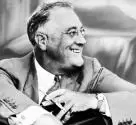A Presidential Visit Prompts a Presidential Secret

I love doing research.
And if there is one thing I have learned about writing, it’s that the more research you do, the easier it is to write.
One of my goals for the month of November had been to finish the rough draft of my next book, Tales of the Grove Park Inn. Earlier last week I had completed the 24th chapter detailing the romantic weekend Barack and Michelle Obama spent at the Grove Park Inn in April of 2010, but I still had a gap to fill regarding an earlier presidential visit in September of 1936.
That fall President Franklin D. Roosevelt was up for his first re-election, and so his staff had planned a three-city driving tour starting in Knoxville (TN), heading up through the recently established Great Smoky Mountain National Park, and down the other side into Asheville. The next day the President would be driven over to Charlotte, where, after yet another campaign speech, he boarded his train bound back to Washington.
Naturally, the President stayed at the Grove Park Inn, in rooms 220 and 221, a corner suite with a commanding view over the golf course and downtown Asheville. His was not a romantic weekend, however, for he and First Lady Eleanor Roosevelt had long since agreed that they enjoyed their romantic weekends in the company of others, but that is yet another tale to be told.
And so on a Friday afternoon, when the majority of the American populous was either shopping, thinking about shopping, or struggling not to feel guilty for not shopping, I was down in the catacombs of Pack Memorial Library, threading spools of microfilms of the September 1936 Asheville Citizen into a bulky reader. As you might imagine, a Presidential visit was big news for a small town of some 25,000 people, a town that reportedly swelled to more than 40,000 people lining the streets and packed into the town’s minor league baseball field for his brief address.
The newspapers that week were filled with stories, sidebars, and tidbits of information (four people were arrested the day of the President’s visit, three for public intoxication and one for driving without a license), plus photograph after photograph after photograph.
And what I found fascinating was the unwritten agreement all newspaper editors, publishers, reporters and photographers steadfastly upheld: no one — regardless of their political affiliation — either described or photographed the polio-stricken President being lifted in and out of his car by Secret Service agents, staggering to clutch the arm of his son John (a sophomore at Harvard along on this trip), leaning on his crutches, or seated in his wheelchair, his lifeless legs bound by metal straps.
You could, as I did that afternoon, read an entire week’s worth of newspaper articles on the President’s visit to North Carolina and the Grove Park Inn and never once find any mention or photographic evidence of the fact that Franklin Roosevelt was paralyzed from the waist down from polio.
How journalism has changed.
The day following his overnight stay at the Grove Park Inn, a stay so thoroughly documented that we not only know precisely which rooms he slept in, but what he ate for each course at every meal, who served it to him, and who sat to his right and to his left as he ate, the President was lifted back into his car and driven through the streets of Asheville to McCormick Field for an 11:00am address before more than 20,000 people.
Twenty thousand people who had never seen a polio-stricken President struggling just to walk across a baseball diamond to a temporary podium.
But this was not a new challenge for the President’s staff, who had arrived in Asheville a few days earlier just to handle such complications. By the time the presidential Packard reached McCormick Field that sunny Friday morning, a large hole had suddenly appeared in the outfield fence, a hole just large enough for a car to drive through on its way to a cluster of microphones mounted on home plate.
As the crowd stood and roared at the sight of the presidential motorcade slowly making its way across the field, the President leaned forward and, as the car stopped and the sound of the engine was extinguished, without even standing up, delivered his address to them.
Thirty minutes later, to another standing ovation, the President, waving his trademark white Panama straw hat, leaned back in his seat as his car pulled away, drove back through the hole in the outfield fence, and made its way down Highway 74 for lunch at Lake Lure and an afternoon speech in Charlotte.
As a sidebar, that same day one special Grove Park Inn guest might well have watched from his fourth floor room as the Secret Service men lifted the President in and out of his car parked on the front terrace of the hotel. That summer a once-famous author lived at the Grove Park Inn, seeking solace in which to revive his flagging career in room 441 — none other than F. Scott Fitzgerald.
But that, too, is another tale to be told.

Until next Monday,
Have a great week!
Bruce
President Roosevelt’s photo courtesy of www.duanegraham.wordpress.com.
